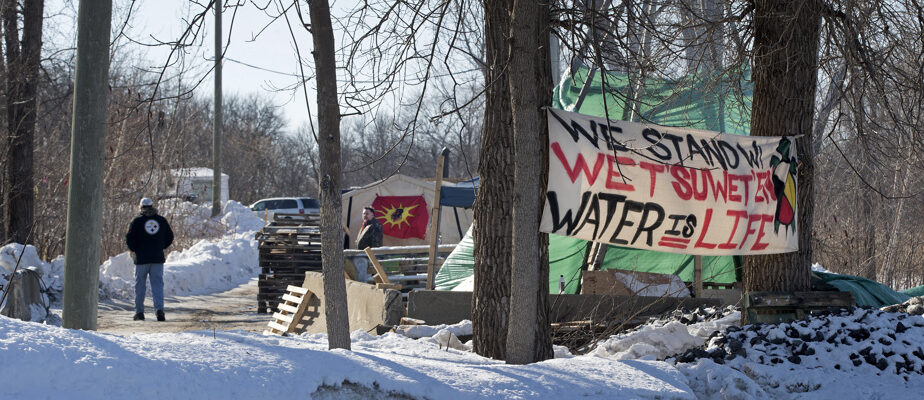(Ottawa) Canada is preparing to adopt its first legislation against environmental racism. Green Party Leader Elizabeth May’s Bill C-226 will soon be subject to a final vote in the Senate. It aims to prevent toxic sites from being installed near Indigenous communities, racialized or marginalized communities.
What there is to know
The federal government is preparing to recognize environmental racism in legislation, a first in Canada.
In doing so, it recognizes that indigenous, racialized or marginalized communities are disproportionately affected by toxic industrial discharges.
The government will adopt a national strategy to counter this phenomenon.
“There are several examples here in Canada, in indigenous communities particularly, but also in black communities,” says M.me May in interview. “I hope that with the bill, they will have more power to refuse the waste and pollution released by other communities. »
There is the mercury contamination of Grassy Narrows First Nation in northern Ontario caused by wastewater discharges from a pulp and paper mill, the petrochemical plants surrounding Aamjiwnaang in the south of Ontario, the Coastal GasLink pipeline that crosses Wet’suwet’en lands in British Columbia, the former landfill that polluted the black community of Shelburne in Nova Scotia for 75 years and even the dump illegal from Kanesatake, Quebec, which, although owned by two members of the community, has long faced inaction from the authorities.
“Where is the Ministry of the Environment? Where is the Ministry of Fisheries or the Ministry of Health? asks Mme May. It’s a completely different situation only because it’s an indigenous community that doesn’t have the power to demand that the government do the basics to protect their health and protect their own safety. »
We don’t know the number of communities across the country affected by this phenomenon, but a project to map them is underway, says McMaster University professor Ingrid Waldron, who has been studying the issue for 12 years.
The principle of environmental justice has been recognized by the United States Environmental Agency (EPA) for 20 years. Former President Bill Clinton signed an executive order in 1994 to combat the harmful and disproportionate effects of pollution on minorities and low-income populations.
The communities most affected are never part of the discussions. They are not invited to participate in decision-making, policy development by regulatory bodies, commissions, etc.
Ingrid Waldron, professor at McMaster University
The bill aims to give them a voice again with the development of a national strategy to counter this phenomenon and the negative impacts it has on their health. The Ministry of the Environment has already launched consultations and Professor Waldron will participate in the work as a consultant. The bill also provides for the conduct of a study and compensation to affected individuals and communities, the amount of which remains to be determined.
“What we are trying to do is to give these communities more tools to be able to assert their rights, particularly in relation to the quality of the environment,” indicated the Minister of Environment, Steven Guilbeault, in the press scrum on Wednesday.
He supported Bill C-226, which he considers to be a complement to the reform of the Canadian Environmental Protection Act adopted last year which includes the right to a healthy environment. A first version of the bill was presented by Liberal MP Lenore Zann in 2020, but died on the order paper. She then lost her seat in 2021.
Conservatives and Bloc members against
However, the legislative text was far from unanimous in the House of Commons. It obtained the support of the Liberals and the New Democrats during the third reading vote, but the Conservatives and the Bloc opposed it for different reasons.
“We already have a complicated regulatory framework when it comes to carrying out projects in Canada,” argued Ontario Conservative MP Kyle Seeback during debates in the chamber. In parliamentary committee, his colleague Gérard Deltell recalled that the Northern Gateway oil pipeline project from Alberta to British Columbia had the support of several indigenous communities before it was stopped by the government in 2016.
The Bloc Québécois would have preferred that the concept of environmental racism be replaced by that of environmental justice. “If we institute new policies based on new rights, such as the right to a healthy environment, everyone should enjoy them, without exception,” argued MP Monique Pauzé.
She gave as an example the district of Limoilou, in Quebec, where residents breathe dust generated by the transshipment of minerals at the port of Quebec, under federal jurisdiction, regardless of their ethnic origin. “The particularity of this neighborhood is that it has very low incomes,” she emphasized.
It is difficult to predict the impact that this bill could have on the development of nuclear energy recommended by the government. The plan to landfill the Chalk River power station to dispose of its radioactive waste had been the subject of strong opposition from various indigenous nations.
